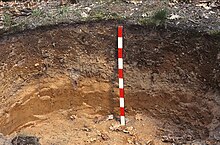Parabrown earth
As Parabraunerde (a lessive ) is called a bottom, wherein the particles of the particle size fraction sound from the upper floor to the lower floor have been displaced. The parabroun earth is a widespread type of soil in the temperate- humid climate made of primarily calcareous loose rock.
The type-defining process is clay relocation , also known as clay silting up. The components of the clay fraction (<2 µm equivalent diameter ), especially clay minerals and iron oxides, are shifted along macropores with the seepage water into the subsoil. A precondition for the relocation of the clay fraction is the dispersion of the clay particles. Since the occurrence of multivalent cations (Ca, Mg, Al) in the soil solution leads to flocculation of the clay minerals, the clay shift is usually only in moderately acidic soils after decalcification and before the onset of silicate weathering in the pH range between pH 7- 5.5 possible. The clay is enriched in the subsoil, which still contains carbonate . Exceptions are soils with high sodium saturation , such as marsh soils influenced by salt water and salt enrichment soils in arid climatic zones , in which, under the influence of monovalent sodium ions, dispersion and consequent clay shift can take place even at higher pH values.
Soil quality and use
The properties and the resulting possible uses of the parabrown earth are very different depending on the parent rock and degree of weathering. It is a sandy to loamy, moderately nutrient-rich, deep and very well rootable soil . The original rock of the soil formation often consists of primarily calcareous loose rock , for example loess . The supply of plant-available water and the nutrient content in loess parabrown soils is usually comparatively good; they are mainly used for arable farming. Ribbon parabroun earths form from sandy substrate, in which the clay particles usually accumulate in ribbons several centimeters thick in the subsoil; they were formerly referred to as ribbon brown earths.
Parabrown earths under forests are usually very acidic. The soil quality is lower on sandy substrate, as the soil dries out more often due to its lower water storage capacity. In addition, if the soil is used for agriculture, due to its low nutrient content, it must be fertilized in order to achieve good yields. On the other hand, parabraunerde has a very high soil quality on loess, sand loess and marl boulder .
Soil horizons
Soil horizons of a parabroun earth are:
- Ah - humic topsoil
- Al - depleted in clay minerals (de-activated); also slightly depleted in iron oxides and organic substances, which migrate as complexes with the clay minerals, and thereby brightened → eluvial horizon
- Bt - enriched with clay minerals (dense, in extreme cases prone to waterlogging) → Illuvial horizon
- possibly Bv - possible with advanced acidification : browning / silting horizon ( silicate weathering )
- C - parent rock
Characteristics: The entire A horizon is silty , less humic towards the bottom. In the Bt horizon the soil is enriched with clay and in the Bv horizon it is finally clayey . The C horizon is calcareous and consists of quartz- and silicate-rich sediments such as loess , boulder clay or glacial gravel .
Systematics
In the German soil systematics , parabroun earths (abbr. LL) belong together with the pale earths to the class of Lessivés (L) within the Terrestrial Soils Department .
In the international soil classification World Reference Base for Soil Resources (WRB) they are depending on cation exchange capacity and base saturation in the Luvisols , Alisols , Acrisols or - - very rare in central Europe Lixisols classified. Humus-rich parabroun earths belong to the Phaeozems or Umbrisols .
In the US soil classification system Soil Taxonomy they are counted among the Alfisols , e.g. B. Udalfs .
literature
- W. Amelung, H.-P. Blume , H. Fleige, R. Horn, E. Kandeler , I. Kögel-Knabner , R. Kretschmar, K. Stahr , B.-M. Wilke: Scheffer / Schachtschabel textbook of soil science. 17th edition. Heidelberg 2018. ISBN 978-3-662-55870-6 .
- Ernst Leitgeb, Rainer Reiter, Michael English, Peter Lüscher, Peter Schad, Karl-Heinz Feger (eds.): Forest floors. An image atlas of the most important soil types from Austria, Germany and Switzerland . Wiley-VCH Verlag GmbH, Weinheim 2013, ISBN 978-3-527-32713-3 (387 pages, approx. 270 colored illustrations).
Web links
- Parabraunerde The magazine for soil and garden on ahabc.de

